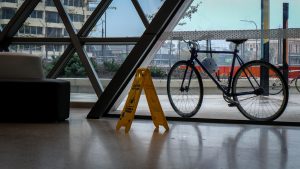4.5.4 Environment Risk Assessment
One key way to reduce fall risk is by conducting an environmental risk assessment to flag areas, practices and items that could contribute to falls. For example, if a floor is mopped and left to dry without a caution sign, this is an environmental risk for a fall to occur. The resources on this page will provide you with insight into how to complete an environmental risk assessment effectively. Work through the materials carefully.
General Guidance
Read “The Unique Occupational Environment of the Home Healthcare Worker” blogpost from the CDC for ways to assess both the home care and health center environments and the risk assessments you need to understand for these health care settings. What are the key pieces of guidance for your work context?
Watch “Fall Prevention in the Home: Changes for Healthy Living” for a home scenario of what high-risk situations can occur and how to reduce the risk. Did the suggestions make sense to you? Do you see these suggestions helping and reducing the risk of falls?

Risks at Home
You CAN Prevent Falls! from the Government of Canada shows detailed room-by-room safety suggestions for home environments. Review the information on the site and answer these questions.
- What are concerns regarding area rugs?
- What are concerns with tile floors?
- The lights are dim in the hallway; why is this a concern?
- The bathroom does not have grab bars; what is the concern with this issue?
- Why should heavy items be stored lower and not above the shoulders?
- Pathways outside have lawn items on them and the inside of the home has pathways going through the home with things stacked around the pathways. What needs to be fixed?
Risks in the Long Term Care Facility
In the work environment associated with client living spaces, safety concerns are easier to assess due to the general safety assessments completed in the facility. The following observations will quickly allow you to determine that safety issues are not present. When you go into the clients room, complete these tasks to address any safety concerns:
- Check that lights are not too dim to allow for better vision and perception.
- Ensure call bell is next to client, so client can easily access help.
- Test call lights to be sure they light up outside of the room and turn off.
- Check that the floor between the client and the bathroom or seating area is clear to reduce tripping hazards.
- Place the bed in the lowest position, so that any fall from the mattress would be less likely to injure the client (If the client has dementia, is there a mat next to the bed in the event of a fall.)
- Make sure that the bed is in the locked position while the client is in bed, so the bed will not move while the client gets in and out of bed.
- Is there a raised toilet seat and grab bars on the walls to hold for stability?
- Is the equipment in the room in good working order?
- Are the client’s shoes in good condition and do they fit well? Shoes that do not fit well may cause the wearer to trip.
- Does the client wear glasses? If their vision is reduced by missing or inappropriate eyewear, it may cause missed or inaccurate steps.
- Does the client wear hearing aids? If hearing is reduced by missing or inadequate hearing aids, it may cause misunderstanding of directions or missed directions, and a sudden change in movements which may cause a person to become off-balance.
Key Takeaway
Your ability to best assist your clients, community, friends and family members relies on your knowledge of the resources available and how to access them when you need them. Search for programs in your community, such as Fall Prevention programs and use them to support your work in reducing risks for your clients. Can you find at least one program that is available in your area?
Answer Key
Here are the answers to the Risks at Home exercise above:
- What are concerns regarding area rugs? They may not have a non-slip backing and could move when stepped on.
- What are concerns with tile floors? Certain tile floors may be slippery to shoes with soles that skid when the floor is waxed or cleaned.
- The lights are dim in the hallway; why is this a concern? The low lighting may cause a problem with depth perception and increase the potential for tripping or falling.
- The bathroom does not have grab bars; what is the concern with this issue? The client may need support in the shower to prevent a fall.
- Why should heavy items be stored lower and not above the shoulders? The lifting of heavy items in high places may increase the need to use a stool and this may increase the potential for a fall.
- Pathways outside have lawn items on them and the inside of the home has pathways going through the home with things stacked around the pathways. What needs to be fixed? The pathways need to be clear to prevent injury, and to make room for help to get through if needed.
Media Attributions
- wet floor © Theen Moy is licensed under a CC0 (Creative Commons Zero) license

